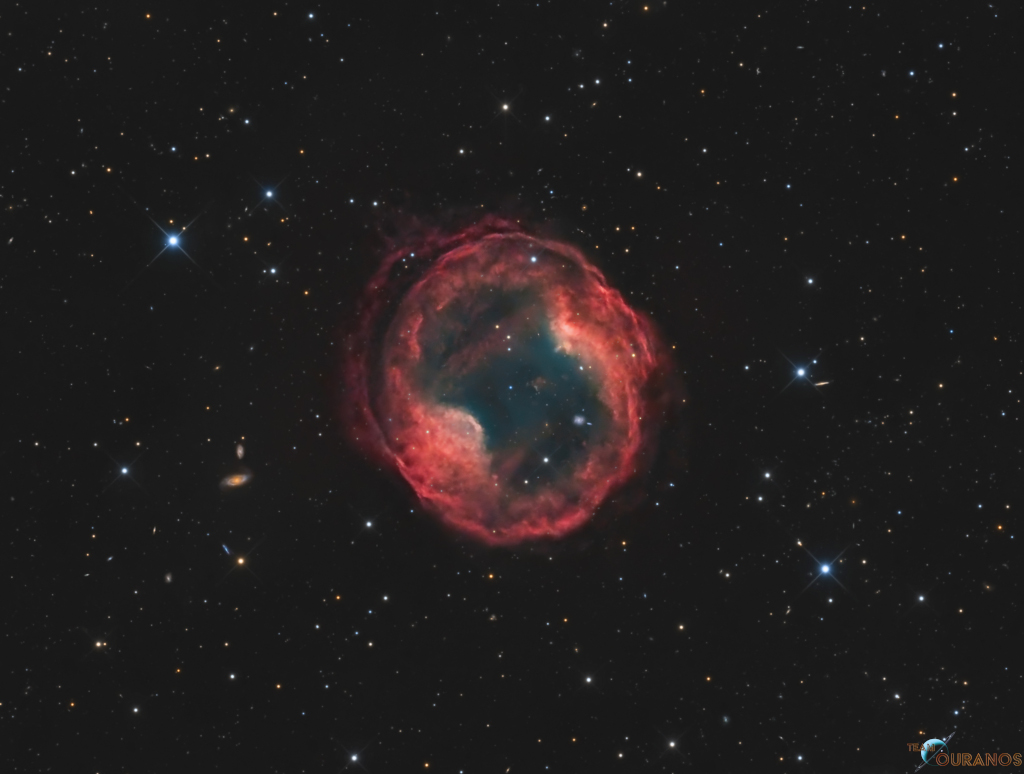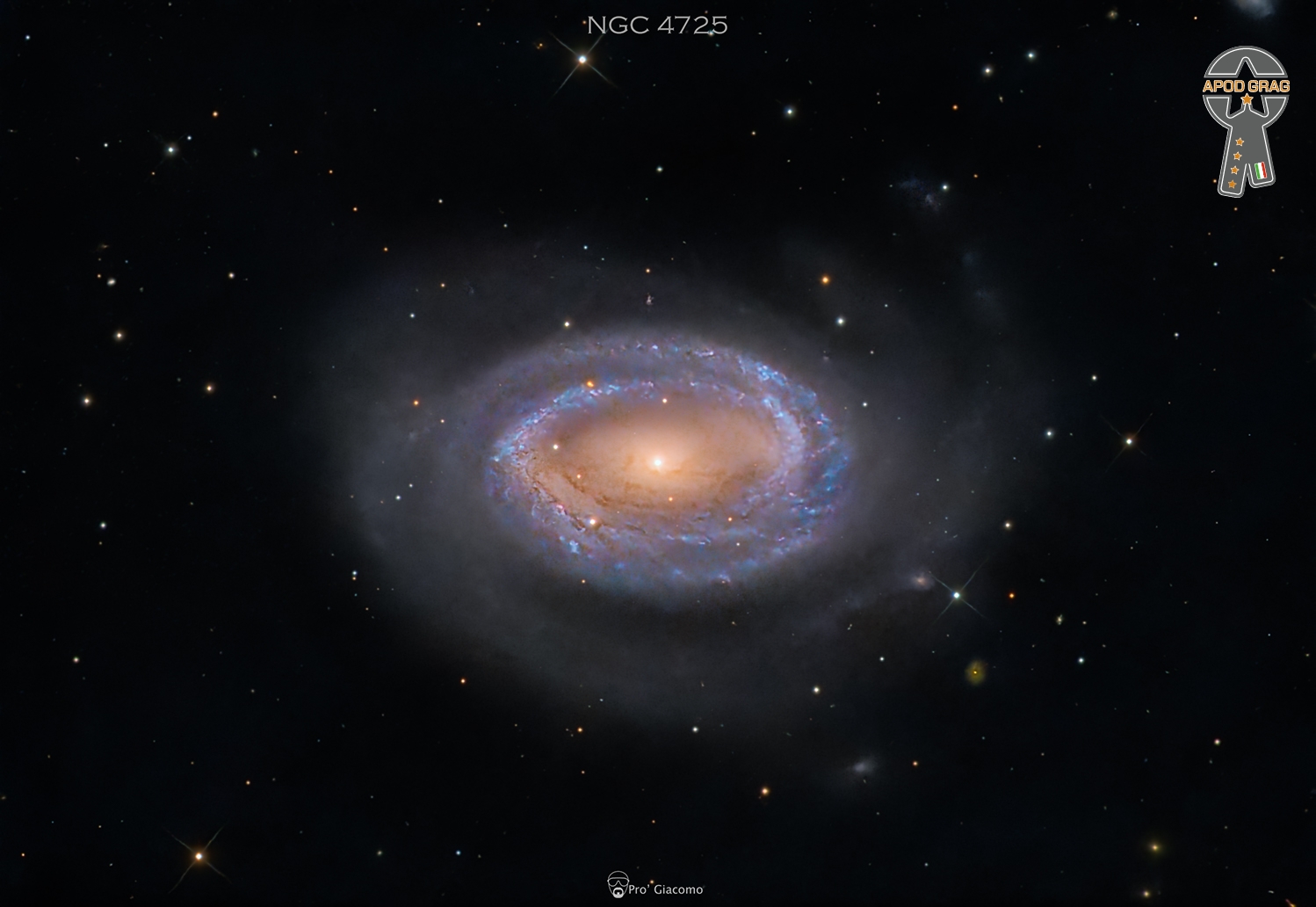Blog
At the Heart of IC 2948 the “Running Chicken Nebula” are large clouds of gas and dust as this region produces newborn stars in what we call a “ Star Factory.” In the upper left corner are a series of Boc globules that remind us of many solar systems like our own, floating in interstellar space. It’s the brightest emission and reflection nebulae in the constellation of Centaurus and lies around 6,500 light-years away.

James Roger McGuinn (born James Joseph McGuinn III; July 13, 1942)is an American musician, best known for being the frontman and leader of the Byrds. He was inducted into the Rock and Roll Hall of Fame for his work with the Byrds. As a solo artist he has released 10 albums and collaborated with, among others, Bob Dylan, Tom Petty and Chris Hillman. The 12-string Rickenbacker guitar is his signature instrument.
McGuinn was born and raised in Chicago, Illinois, son of James Joseph McGuinn Jr (b. 1909) and Dorothy Irene (b. 1911), daughter of engineer Louis Heyn. His parents worked in journalism and public relations, and during his childhood, they had written a bestseller titled Parents Can’t Win. He attended the Latin School of Chicago. He became interested in music after hearing Elvis Presley‘s “Heartbreak Hotel“, and asked his parents to buy a guitar for him. (During the early 1980s, he paid tribute to the song that encouraged him to play guitar by including “Heartbreak Hotel” in his autobiographical show.) Around the same time, he was also influenced by country artists and/or groups such as Johnny Cash, Carl Perkins, Gene Vincent and the Everly Brothers.
more...Albert Ayler (July 13, 1936 – November 25, 1970) was an American avant-garde jazz saxophonist, singer and composer.
After early experience playing R&B and bebop, Ayler began recording music during the free jazz era of the 1960s. However, some critics argue that while Ayler’s style is undeniably original and unorthodox, it does not adhere to the generally accepted critical understanding of free jazz. In fact, Ayler’s style is difficult to categorize in any way, and it evoked incredibly strong and disparate reactions from critics and fans alike. His innovations have inspired subsequent jazz musicians.
His trio and quartet records of 1964, such as Spiritual Unity and The Hilversum Session, show him advancing the improvisational notions of John Coltrane and Ornette Colemaninto abstract realms where whole timbre, and not just mainly harmony with melody, is the music’s backbone. His ecstatic music of 1965 and 1966, such as “Spirits Rejoice” and “Truth Is Marching In”, has been compared by critics to the sound of a brass band, and involved simple, march-like themes which alternated with wild group improvisationsand were regarded as retrieving jazz’s pre-Louis Armstrong roots. Ayler disappeared on November 5, 1970, and he was found dead in New York City’s East River on November 25, a presumed suicide.For some time afterwards, rumors circulated that Ayler had been murdered, with a long-standing urban legend that the Mafia had tied him to a jukebox.
more...
Peter Michael Escovedo Jr. (born July 13, 1935 in Pittsburg, California) is an American percussionist.
With his two brothers, he formed the Escovedo Bros Latin Jazz Sextet, before Carlos Santana hired Pete and Coke Escovedo for his group, Santana. Peter led the 14–24 piece Latin big band Azteca.
more...Leroy Vinnegar (July 13, 1928 – August 3, 1999) was an American jazz bassist. Born in Indianapolis, Indiana, United States, the self-taught Vinnegar established his reputation in Los Angeles, California, during the 1950s and 1960s. His trademark was the rhythmic “walking” bass line, a steady series of ascending or descending notes, and it brought him the nickname “The Walker”. Besides his jazz work, he also appeared on a number of soundtracks and pop albums, notably Van Morrison‘s 1972 album, Saint Dominic’s Preview.He recorded extensively as both a leader and sideman. He came to public attention in the 1950s as a result of recording with Lee Konitz, André Previn, Stan Getz, Shorty Rogers, Chet Baker, Shelly Manne, Joe Castro and Serge Chaloff.
more...Opening night Friday July 12th 7pm running through July 21st; 6 shows at Caponi Art Park in Eagan. Music with Raymond Berg, Lyra Olson, Paul Fontara, Anthony Afful and mick laBriola.

more...
Planetary nebula Jones-Emberson 1 is the death shroud of a dying Sun-like star. It lies some 1,600 light-years from Earth toward the sharp-eyed constellation Lynx. About 4 light-years across, the expanding remnant of the dying star’s atmosphere was shrugged off into interstellar space, as the star’s central supply of hydrogen and then helium for fusion was depleted after billions of years. Visible near the center of the planetary nebula is what remains of the stellar core, a blue-hot white dwarf star. Also known as PK 164 +31.1, the nebula is faint and very difficult to glimpse at a telescope’s eyepiece. But this deep image combining over 12 hours of exposure time does show it off in exceptional detail. Stars within our own Milky Way galaxy as well as background galaxies across the universe are scattered through the clear field of view. Ephemeral on the cosmic stage, Jones-Emberson 1 will fade away over the next few thousand years. Its hot, central white dwarf star will take billions of years to cool.

Christine Anne McVie 12 July 1943 – 30 November 2022) was an English musician and singer. She was the keyboardist and one of the vocalists and songwriters of Fleetwood Mac.
McVie was a member of several bands, notably Chicken Shack, in the mid-1960s British blues scene. She initially began working with Fleetwood Mac as a session player in 1968, before officially joining the band two years later. Her first compositions with Fleetwood Mac appeared on their fifth album, Future Games. She remained with the band through many changes of line-up, writing songs and performing lead vocals before partially retiring in 1998. McVie was described as “the prime mover behind some of Fleetwood Mac’s biggest hits” and eight songs she wrote or co-wrote, including “Don’t Stop“, “Everywhere” and “Little Lies“, appeared on Fleetwood Mac’s 1988 Greatest Hits album. She appeared as a session musician on the band’s last studio album, Say You Will. McVie also released three solo studio albums and recorded a duet album with Lindsey Buckingham.
As a member of Fleetwood Mac, McVie was inducted into the Rock and Roll Hall of Fame and in 1998 received the Brit Award for Outstanding Contribution to Music. In the same year, after almost 30 years with Fleetwood Mac, she left the band and lived in semi-retirement, releasing a solo album in 2004. She appeared on stage with Fleetwood Mac at the O2 Arena in London in September 2013 and rejoined the band in 2014 prior to their On with the Show tour.
McVie received a Gold Badge of Merit Award from BASCA, now The Ivors Academy, in 2006. She received the Ivor Novello Award for Lifetime Achievement from the British Academy of Songwriters, Composers and Authors in 2014 and was honoured with the Trailblazer Award at the UK Americana Awards in 2021. She was also the recipient of two Grammy Awards.
more...
John Patton (July 12, 1935 – March 19, 2002) was an American jazz, blues and R&B pianist and organist often known by his nickname, Big John Patton.
Patton was one of the most in-demand organists during the golden era of the Hammond B-3 organs between 1963 and 1970.He recorded extensively for Blue Note and performed or collaborated with Lloyd Price, Grant Green, and Lou Donaldson. Patton had a lower profile in the 1970s but enjoyed a comeback in the 1980s and 1990s, often in collaboration with saxophonist John Zorn. His later music incorporated modal and free jazz.
John Patton, born in Kansas City, Missouri, United States, was an American jazz composer and performer. He developed the nickname “Big John”, not because of his size, but because of a song. “Remember the tune, ‘Big Bad John’? … yeah, well, that’s what they started calling me and at first I didn’t understand it but I love it now. It’s just a name; if it’s going to help you, then boogie on up in there!”
more...
Paul Gonsalves (July 12, 1920 – May 15, 1974) was an American jazz tenor saxophonist best known for his association with Duke Ellington. At the 1956 Newport Jazz Festival, Gonsalves played a 27-chorus solo in the middle of Ellington’s “Diminuendo and Crescendo in Blue,”[2] a performance credited with revitalizing Ellington’s waning career in the 1950s.
Born in Brockton, Massachusetts, to Portuguese Cape Verdean parents, Gonsalves’ first instrument was the guitar, and as a child he was regularly asked to play Cape Verdean folk songs for his family. He grew up in New Bedford, Massachusetts, and played as a member of the Sabby Lewis Orchestra. His first professional engagement in Boston was with the same group on tenor saxophone, in which he played before and after his military service during World War II. He also played with fellow Cape Verdean Americans in Phil Edmund‘s band in the 1940s. Before joining Duke Ellington’s orchestra in 1950, he also played in big bands led by Count Basie (1947–1949) and Dizzy Gillespie (1949–1950).
more...Wilbur Schwichtenberg (July 12, 1912 – July 15, 1989), known professionally as Will Bradley, was an American trombonist and bandleader during the 1930s and 1940s. He performed swing, dance music, and boogie-woogie songs, many of them written or co-written by Don Raye.
Born in Newton, New Jersey, Wilbur Schwictenberg was raised in Washington, New Jersey. In 1928, he moved to New York City and became a member of bands such as Red Nichols & His Five Pennies. During the 1930s, except for one year with the Ray Noble orchestra, he was studio musician for CBS Radio, and was the resident hot trombonist on the network’s popular jam session The Saturday Night Swing Club. He also led the studio band for the Summer Silver Theater on CBS in 1941, with Ed Sullivan as the show’s host.
more...Tientos, a slow cante jondo music and dance in a four-count rhythm, was first developed by the singer Enrique el Mellizo (1848 -1906) as an expressive variation of the Tangos. Poet Federico García Lorca considered the Tientos to be almost liturgical in its solemnity. Traditional Tientos lyrics – letras – set a dark mood, and have to do with loss, unrequited love, imprisionment, longing for freedom and other serious messages. Dancers strive to capture this mood in their solos. The most notable aspect of the slow Tientos tempo is the beat structure. Where the first beat in Tangos is subdued, it is strongly emphasized in the Tientos, as is the “and” of the second beat.
more...NGC 4725 is an intermediate barred spiral galaxy with a prominent ring structure, located in the northern constellation of Coma Berenices near the north galactic pole. It was discovered by German-born British astronomer William Herschel on April 6, 1785. The galaxy lies at a distance of approximately 40 megalight-years from the Milky Way. NGC 4725 is the brightest member of the Coma I Group of the Coma-Sculptor Cloud, although it is relatively isolated from the other members of this group. This galaxy is strongly disturbed and is interacting with neighboring spiral galaxy NGC 4747, with its spiral arms showing indications of warping. The pair have an angular separation of 24′, which corresponds to a projected linear separation of 370 kly. A tidal plume extends from NGC 4747 toward NGC 4725.

Thurston Harris (July 11, 1931 – April 14, 1990) was an American singer and songwriter, best known for his 1957 hit “Little Bitty Pretty One“. Harris first appeared on record in 1953. He was the vocalist for South Central Los Angeles R&B band the Lamplighters. He remained with the band as it evolved through several name changes, from the Tenderfoots to the Sharps. In 1954, the Lamplighters appeared at the Tenth Cavalcade of Jazz concert at Wrigley Field in Los Angeles produced by Leon Hefflin Sr. alongside Count Basie, Louis Jordon, the Flairs, Perez Prado, Christine Kittrell, and Ruth Brown.
more...Michael Rose (born 11 July 1957) is a Jamaican reggae singer. He is most widely known for a successful tenure as the lead singer for Black Uhuru from 1977 to 1984, followed by a lengthy solo career. He has been praised as “one of Jamaica’s most distinguished singers” and for launching a distinctive form of reggae singing that originated in his home neighborhood of Waterhouse in Kingston.
Rose began performing at talent contests and in the Jamaican hotel circuit as a teenager, and recorded his first single “Woman a Gineal fe True” at age 15 with producer Newton Simmons. Rose’s childhood friend Sly Dunbar then introduced him to producer Niney the Observer, with whom he recorded several singles in 1972. Rose also recorded a song with Lee “Scratch” Perry during this period.
more...7-11-1938
Terry Garthwaite is an internationally known singer, songwriter, composer, producer, and teacher. Her recording career dates back to the late 1960s when she and Toni Brown formed the rock group Joy of Cooking. She recorded several albums with the band, and then a dozen others by herself or in collaboration with other jazz and blues musicians.
Terry has also produced recordings by other artists including Jasmine, Rosalie Sorrels, Rhiannon, Nicholas, Glover &Wray, Hunter Davis, Robin Flower, and Ferron, whose Garthwaite-produced Shadows on a Dime was awarded four stars by Rolling Stone.
In performance she has shared the stage with such artists as BB King, Janis Joplin, Bonnie Raitt, The Band, Allen Ginsberg, Santana, Rosalie Sorrels and writer Bobbie Hawkins at venues that include Carnegie Hall, the Joseph Papp Theater, the Hollywood Bowl, and Canadian Folk Festivals.
Terry’s recent recordings and writing reflect an awareness of the healing nature of music. In 1992 she recorded her critically acclaimed Affirhythms – rhythmic affirmation chantsongs, and followed it in 2000 with Sacred Circles, songs of hope and heart.
In 2006, Terry began collaborating again with Toni Brown to put together a Joy of Cooking compilation. They pored through old tapes of live performances and studio forays–from their earliest beginnings in 1968–to find the best material with the best performances. The result is the double CD “Back to Your Heart”, one disc of studio takes of never-released songs, and the other a live Berkeley concert from the early ’70s.
She’s published a book, Joy of Sound – Explorations in Awareness Through Sound and Song, that includes vocal games/exercises and a CD of chants, as well as a couple of small books of Alliterhythms–pithy positive songs and sayings in alliteration. Most of her songs are available in her songbooks.
Terry’s music is an array of songs and sounds that encourages empowerment and delight, and radiates the healing nature of music. She currently leads vocal retreats, drum circles, and classes in singing together, playing with sound, and digging the musical garden.
More Posts
- World Drumming Mamady Keïta & Eitetsu Hayashi
- Jack DeJohnette
- Butch Warren
- World Music Balsamic
- Daily Roots Scientist
- Cosmos NGC 4038/39
- John Renbourn
- Benny Carter
- World Fusion Ballaké Sissoko
- Daily Roots Joe Gibbs and the Professionals
- Cosmos NGC 6684
- Rahsaan Roland Kirk
- George Van Eps
- Luckey Roberts
- World Music Anoushka Shankar
- Daily Roots Yabby You
- JEWBALAYA @ Slavic Experience Festival
- Cosmos SN 1006
- Regina Carter
- Ravi Coltrane